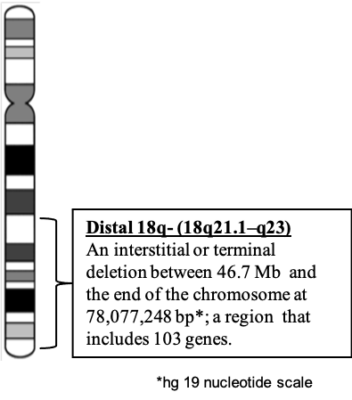Distal 18q- Treatment and Surveillance
 ICD-10 = Q99.9 or Q93.89
ICD-10 = Q99.9 or Q93.89
These recommendations are inclusive of the entire population of people with Distal 18q deletions even though each person has a unique deletion. Therefore each person’s deletion could have different genes that are hemizygous. The specific hemizygous genes for an individual patient will dictate the probability of particular phenotypes. Guidance for creating an individualized plan for evaluation and management based on the person’s specific deletion can be found in the next section. However, the information in this document encompasses the global distal 18q- evaluation and management plan.
Potential conditions in a neonate
- Structural
- Hernias (inguinal, umbilical)
- Cryptorchidism, chordee, and hypospadias in >50% of males
- Palate abnormality
- Functional
- Respiratory and feeding difficulties
- Hypotonia
- Biochemical
- Jaundice
Initial evaluations after diagnosis
- Cardiology evaluation – 29% have cardiac defects
- Orthopedic exam – 74% with foot defects
- Otolaryngology including audiology evaluation
>50% with hearing loss - Thyroid levels – 15% with hypothyroidism
- Renal ultrasound -18% with reflux or malformations
- Ophthalmology exam – 72% with optic problems
- Genitourinary
- Neurology/cerebral MRI evaluation
- Pediatric anesthesiology if surgery is indicated
Referrals to
- Appropriate subspecialist as indicated by initial evaluations
- Genetics Follow-up
- Parents genotyped for balanced rearrangements
- Early intervention/developmental services
- The Chromosome 18 Registry & Research Society
- The Chromosome 18 Clinical Research Center
Closely monitor and manage
- Failure to thrive/growth failure
- Weight gain
- Linear growth
- Sinus/ear infections
- Genitourinary
- Reflux
- Immunology/Rheumatology
- IgA deficiency
- Atopic disorders
- Arthritis
- Other autoimmune conditions
- Neurology
- Seizure disorder
- Intention tremors
- Hypotonia
- Orthopedics
- Scoliosis or kyphosis
- Development
- Milestones
- Pyschometric data
- Behavioral/mood changes
Annual Screenings
- Thyroid
- Vision
- Hearing
Current Adult Status
Age and Cause of Death
Potential conditions in a neonate:
- Structural
- Hernias (inguinal, umbilical)
- Cryptorchidism, chordee, and hypospadias in >50% of males
- Palate abnormality
- >40% with abnormalities, including: high, narrow, wide, bifid uvula, submucus cleft, cleft
palate alone or cleft lip and palate.
- >40% with abnormalities, including: high, narrow, wide, bifid uvula, submucus cleft, cleft
- Functional
- Respiratory and feeding difficulties
- Hypotonia
- Biochemical
- Jaundice
Initial Evaluations:
- Cardiology
- 29% had a cardiac abnormality and of those
- 43% has an ASD or VSD
- 38% had pulmonic stenosis.
- No definitive region of the chromosome is associated with CHD implying there is more than one
gene on 18q impacting the development of the heart.
- The actual incidence of heart defects may be higher as ultrasound and ECG evaluations have not
been consistently been performed on all affected individuals.
- 29% had a cardiac abnormality and of those
- Orthopedics
- 74% have a foot deformation:
- Clubfoot, vertical talus, metatarsus adductus, pes planus or pes cavus.
- The critical region for vertical talus is between 73 and 75.5 Mb
- Scoliosis or kyphosis –possibly related to hypotonia
- 74% have a foot deformation:
- Audiology
- Within the total population of people with 18q deletions:
- 49.5% had conductive hearing loss
- 28% had sensorineural hearing loss
- 78% of individuals whose deletion includes the TSHZ1 gene at 73 Mb have ear canal stenosis/atresia often leading to conductive hearing loss.
- Within the total population of people with 18q deletions:
- Otolaryngology
- Aural atresia/stenosis common
- Middle ear effusion common
- Normal pinnae
- Thyroid levels
- 15% have developed thyroid dysfunction, often at <10 years of age
- Antibody positive hypothyroidism is the most common, by far
- Hyperthyroidism has been reported
- 15% have developed thyroid dysfunction, often at <10 years of age
- Renal ultrasound
- 25% with a deletion including the region from 73.1 –75.1 Mb have a renal malformation
- Ophthalmology
- Strabismus 40%, nystagmus 29 % , myopia 35%
- Nystagmus critical region is from 72.6-75.1 Mb
- Genitourinary
- Infants with genital abnormalities should be evaluated by a pediatric urologist in the first month of life. Treatment should be initiated on the same timetable as would be used for typical infants
- Neurology
- MRI findings:
- 97% have CNS dysmyelination (i.e. delayed myelination ), although 100 % of those individuals missing a region between 74.3 and 73.5 Mb have dysmyelination, it is not a progressive degenerative condition.
- 47% Paranasal Sinus Disease (Maxillary or Ethmoid sinusitis)
- 26% Mastoiditis
- 34% Enlargement of Ventricular System (possibly related to brain hypoplasia; corpus callosum hypoplasia or white matter loss)
- 32% Delayed maturation of Occipital lobes
- 14% Brain abnormal signals
- 14% Corpus Callosum abnormalities (thinner, smaller, partial or total agenesis)
- 14% Iron deposition
- 6% Pituitary gland abnormalities
- 3%Virchow-Robin Perivascular spaces
- 2.5% Deep white matter ischemia
- 1.7% Periventricular Leukomalacia
- 1.7% Dandy-Walker variant
- 1.7% Chiari I malformation
- MRI findings:
- There is no reason to think that they are at increased risk for surgical or anesthesia complications although they may need increased monitoring due to hypotonia.
Referrals to:
- Genetics Follow-up
- Genetics follow-up may be necessary if parental chromosomes have not been evaluated to rule out inherited rearrangement. 3% of the participants in our study have a parent with a balanced rearrangement. Even if no other children are planned, if one parent has a balanced rearrangement then their other children or the siblings of that parent are a risk for having the same rearrangement and consequently have a very high risk of passing on an unbalanced chromosome compliment.
-
- A genetics follow-up may also be indicated if the original diagnosis was performed using cytogenetic techniques or low resolution microarray technology. A high resolution SNP or CGH microarray can determine exactly which genes are involved in the deletion. This information will become increasingly important over time as gene-specific interventions are developed.
-
- Genetics follow-up may be necessary if parental chromosomes have not been evaluated to rule out inherited rearrangement. 3% of the participants in our study have a parent with a balanced rearrangement. Even if no other children are planned, if one parent has a balanced rearrangement then their other children or the siblings of that parent are a risk for having the same rearrangement and consequently have a very high risk of passing on an unbalanced chromosome compliment.
- Early intervention/developmental services
- All children with chromosome 18 abnormalities are at significant risk for developmental delay. Prompt referral to a program the includes physical, occupational and speech therapy is important in order maximize their development.
-
- 100% have developmental delay
-
- 91% have speech problems
- 32% articulation
- 17% non-verbal
- 18% delayed speech development
- 7% apraxia
- 26% not-specified
-
- 79% have hypotonia
- 68% have an intellectual disability
- 100% have developmental delay
-
- All children with chromosome 18 abnormalities are at significant risk for developmental delay. Prompt referral to a program the includes physical, occupational and speech therapy is important in order maximize their development.
- Referral to Chromosome 18 Registry & Research Society
- The Chromosome 18 Registry is a parent support organization that provides family members with the opportunity to meet and learn from those who have gone before them. These are complex conditions to manage even in the least affected children making the establishment of a network of support a crucial component for maximizing the affected child’s potential. The Registry has annual national and international conferences, regional get-togethers and social media outlets, all with programs for parents, siblings and affected adults. The Registry works closely with and financially supports the Chromosome 18 Clinical Research Center.
- Referral to the Chromosome 18 Clinical Research Center
- The goal of the Chromosome 18 Clinical Research Center is to make the chromosome 18 abnormalities the first treatable chromosome abnormalities. Anyone with any chromosome 18 abnormality is eligible to enroll and encouraged to enroll. Once enrolled, participants have the opportunity to be involved in longitudinal studies of developmental progress, and when available, other studies that could include surveys or treatment trials. Families enrolled in the Research Center will also be the first to know new information about the conditions when it becomes available. Enrollment is a key part of proactive clinical management. Click here to enroll today.
There is additional information on each of the areas mentioned above within the downloadable PDF document.
Updated 2020

